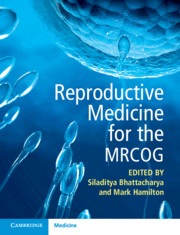Book contents
- Reproductive Medicine for the MRCOG
- Reproductive Medicine for the MRCOG
- Copyright page
- Contents
- Contributors
- Chapter 1 Epidemiology and Initial Assessment of the Infertile Patient
- Chapter 2 Disorders of Ovulation and Reproductive Endocrine Disorders Associated with Infertility
- Chapter 3 Endometriosis
- Chapter 4 Uterine and Tubal Causes of Infertility
- Chapter 5 Andrology and Infertility
- Chapter 6 Unexplained Infertility
- Chapter 7 Assisted Reproduction
- Chapter 8 Adjuvants in Assisted Reproduction
- Chapter 9 Laboratory Procedures for Assisted Reproduction
- Chapter 10 Fertility Preservation
- Chapter 11 Third-Party Reproduction
- Chapter 12 Managing Ethical Dilemmas in Reproductive Medicine
- Chapter 13 Evidence-Based Reproductive Medicine
- Chapter 14 The Organisation of Services and Quality Assurance in Fertility Practice
- Index
- References
Chapter 5 - Andrology and Infertility
Published online by Cambridge University Press: 25 February 2021
- Reproductive Medicine for the MRCOG
- Reproductive Medicine for the MRCOG
- Copyright page
- Contents
- Contributors
- Chapter 1 Epidemiology and Initial Assessment of the Infertile Patient
- Chapter 2 Disorders of Ovulation and Reproductive Endocrine Disorders Associated with Infertility
- Chapter 3 Endometriosis
- Chapter 4 Uterine and Tubal Causes of Infertility
- Chapter 5 Andrology and Infertility
- Chapter 6 Unexplained Infertility
- Chapter 7 Assisted Reproduction
- Chapter 8 Adjuvants in Assisted Reproduction
- Chapter 9 Laboratory Procedures for Assisted Reproduction
- Chapter 10 Fertility Preservation
- Chapter 11 Third-Party Reproduction
- Chapter 12 Managing Ethical Dilemmas in Reproductive Medicine
- Chapter 13 Evidence-Based Reproductive Medicine
- Chapter 14 The Organisation of Services and Quality Assurance in Fertility Practice
- Index
- References
Summary
Reproductive problems in the male contribute significantly to subfertility in heterosexual couples but can also impact on the ability of single or homosexual men to take part in donation or surrogacy. The main causes of reproductive problems in males can be classified as either (1) pre-testicular (those affecting the regulatory hormonal pathway); (2) testicular (those which relate to impaired testicular function); and (c) post-testicular, where there is a blockage of the male genital tract or other problems with associated ejaculation or sperm delivery; however, it is possible that there can be more than one cause. The main diagnostic procedures include physical examination, followed by semen analysis and, in some instances, endocrine tests (follicle-stimulating hormone and testosterone), genetic tests (karotyping, Y chromosome microdeletion testing and cystic fibrosis testing) and radiological investigations. In the case of secondary hypogonadism, medical treatment with human chorionic gonadotropin can improve sperm quality but in the majority of azoospermic men only various surgical interventions to recover sufficient sperm for intracytoplasmic sperm injection are of proven value.
Keywords
- Type
- Chapter
- Information
- Reproductive Medicine for the MRCOG , pp. 43 - 53Publisher: Cambridge University PressPrint publication year: 2021



